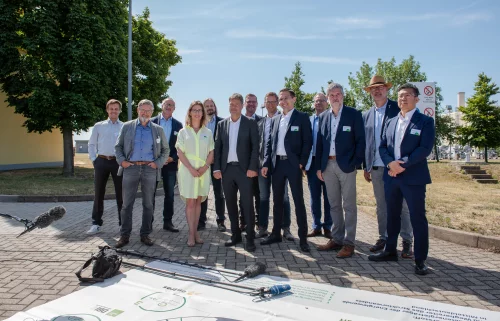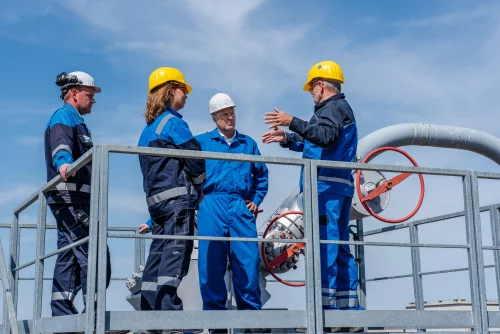Federal Minister Dr. Robert Habeck visits Bad Lauchstädt Energy Park
- Real-world laboratory on the hydrogen value chain shows ways out of the energy crisis
Federal Minister Dr. Robert Habeck visited the town of Bad Lauchstädt today at the start of his two-day “Business and work in times of crisis” tour of three federal states. Robert Habeck on site at the Bad Lauchstädt Energy Park in southern Saxony-Anhalt. In the current tense situation on the energy markets, he took it upon himself to learn about the innovation project “Bad Lauchstädt Energy Park”, which is also being funded by the Federal Ministry for the Economy (“BMWK”) as a real-life laboratory for the energy transition. He was particularly interested in the progress of the project and the prospects that this project offers for shaping the energy transition and as a way out of existing dependencies in the future.
“The Federal Government is doing everything it can to ensure security of supply for the coming winter. It is crucial that we free ourselves step by step and sector by sector from the clutches of Russian imports. An accelerated energy transition and rapid expansion of renewable energies are essential for a secure energy supply and are more important today than ever before. We must consistently take the necessary steps to reach climate neutrality. A key aspect of this is hydrogen produced from renewable energies. At the Bad Lauchstädt Energy Park, a value chain comprising wind energy, hydrogen conversion, storage, transport and utilisation is being modelled for this purpose. Such flagship projects show that the energy transition works on a large scale,” explained Dr. Robert Habeck, Federal Minister for Economic Affairs and Energy on the occasion of his visit.
“We launched this project with a view to promoting the energy transition in Germany and the associated structural change in the Central Germany region. The current energy policy situation is of course an additional motivation for us to make this project a success. The intensive dialogue with Minister Habeck gave us the opportunity to look together at the potential, but also the challenges that lie ahead of us on the way to establishing the Bad Lauchstädt Energy Park,” explains Cornelia Müller-Pagel, Head of Green Gases at VNG AG, project coordinator and spokesperson for the consortium.
Present status of the project
After the project was launched in September last year, the consortium partners started work on the individual sub-projects at full speed. The focus was on engineering planning, which is also the basis for the various authorisation and notification procedures. The consortium partners are in close dialogue with each other in order to develop and coordinate various interfaces. At the same time, the companies are involved in various aspects of site preparation, such as soil analyses and surveying. Of particular importance in this initial project phase is the development of a viable business model, which must be based on a binding regulatory framework. This point has posed a particular challenge for project sponsors to date, as the publication of the Delegated Act - RED II at European level was delayed by several months. The approval and authorisation procedures for the wind farm, electrolyser, storage facility and gas purification system have so far largely gone according to plan.



